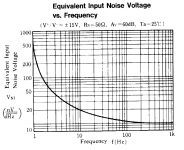JRC claims noise for it's NJM2060 quad opamp as 1.2uV RMS (RIAA Rs=2.2k, 30kHz LPF). How much is that in nV/rtHz?
Normally you integrate the nV/rt Hz over the audio BW to get the total uV noise, which can be arrived at by simply multiplying the nV/rt Hz by the square root of the BW.
In your case, take the square root of 30 000 and divide it into the uV noise.
In your case, take the square root of 30 000 and divide it into the uV noise.
That's the pseudo RIAA circuit noise assuming no cartridge inductance, which has a much smaller noise bandwidth than 30kHz, due to the RIAA curve, and ignores most of the effect of current noise.
The graph for voltage noise alone suggests 13nV/√Hz, not great especially with the fairly high 1/f knee-point.
The bias current spec suggests its a bias-current cancellation scheme, not sure what the its current noise would be, but it will push the actual MM input equivalent noise higher than 1.2uV in reality.
The graph for voltage noise alone suggests 13nV/√Hz, not great especially with the fairly high 1/f knee-point.
The bias current spec suggests its a bias-current cancellation scheme, not sure what the its current noise would be, but it will push the actual MM input equivalent noise higher than 1.2uV in reality.
The graph for voltage noise alone suggests 13nV/√Hz, not great especially with the fairly high 1/f knee-point.
That plot has a slight mis-labeling, I think the first 3 lines are 8, 9, 10.
NJM2060 is four NJM4560 in the same package. This is very old and jellybean opamp. It's not intended for RIAA circuit. I bought it because it's now difficult to find something better, some high performance quads in DIP package and I needed it for Baxandall active gain control (with max gain of 5 times). Although this is jellybean opamp, subjective performance in the Baxandall active gain control is absolutely spectacular. I like the sound much better than LM4562 in noninverting mode. LM4562, in spite of been state of the art modern audio opamp, sounds raw in HF. Baxndall circuit sounds so cultivated, but still with all the necessary detail and resolution, even with jellybean NJM 2060. And sound stage is great. It's absolutely fascinating how the right circuit allows even low down and dirty component to glow. But please note that I use old Tannoy pepper pot compression horn dual concentric. This loudspeaker is notorious for showing any HF misbehavior in amplification. That's why it's not very popular for home audio. In noninverting mode LM4562 sounds worse than NJM2060 in Baxandall active gain control. One thing I noticed from my third Baxandall circuit build is that it is necessary to have gain at least 5 to get the right sound. The circuit is TI verified design TIDU034, almost complete copy of Doug Self's active gain stage from Precision Preamplifier.
I am perplexed if the complete lack of CM distortion is the reason why inverting mode sounds so good. When you read Doug's "Small signal audio" you see that inverting mode has lower distortion, but absolute distortion level is only slightly higher than for the noninverting mode. I can't believe that such small differences in distortion level can make such huge subjective difference. Inverting mode is much more "musical". I wonder if Rega ElexR sound so good because it uses Baxandall active gain control in preamp stage.
I have no other reasonable explanation but that CM distortion is very bad for the sound. Doug does not explain in the book if, and how, CM distortion changes with gain. Is it proportional to the gain? If it's proportional to the gain, than RIAA circuit is the worst case scenario for CM distortion. May be that's the reason why John Lynsley Hood liked inverting configuration so much more than noninverting configuration for RIAA stage. If that's the reason than may be it's better to sacrifice noise performance just to get rid of the CM distortion.
Last edited:
Normally you integrate the nV/rt Hz over the audio BW to get the total uV noise, which can be arrived at by simply multiplying the nV/rt Hz by the square root of the BW.
In your case, take the square root of 30 000 and divide it into the uV noise.
Ahh. I did not read the question properly. The RIAA curve changes everything.
The only change I made in the TIDU034 circuit is that R8=5k1, not 1k. I made it preamplifier instead of attenuator. I even used TSV diodes at the input.
With Hank Mobley's late 50s Blue Note recordings, which have specific brightness (tube condenser mics + tube tape recorders = bright sound), all the brightness is still there but without any hint of aggressiveness or fatigue. Cymbals and hi-hat are almost mellow, and brass and reeds lost unnatural brightness. Everything is so clear and transparent. Amazing.
With Hank Mobley's late 50s Blue Note recordings, which have specific brightness (tube condenser mics + tube tape recorders = bright sound), all the brightness is still there but without any hint of aggressiveness or fatigue. Cymbals and hi-hat are almost mellow, and brass and reeds lost unnatural brightness. Everything is so clear and transparent. Amazing.
Attachments
- Home
- Source & Line
- Analog Line Level
- Opamp noise recalculation
